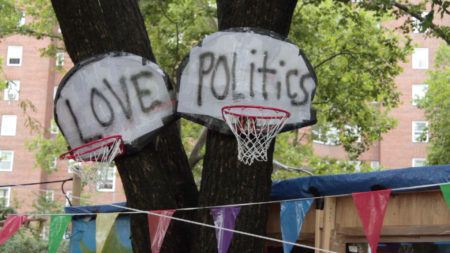Continue playing
(Time remaining: )
Play from beginning
Continue playing "{{ controller.videos[controller.getVideo(controller.currentVideo)].segmentParentTitle}}"
{{controller.videos[controller.getVideo(controller.currentVideo)].title}} has ended.
Thomas Hirschhorn in "Investigation"
While enlisting the participation of the residents of a Bronx public housing development to develop a sprawling installation out of everyday materials, Thomas Hirschhorn poses political and philosophical questions, and searches for alternative models of thinking and being. The process leads to the creation of a new kind of monument that, while physically ephemeral, lives on in collective memory.
Credits
Series Created By: Susan Dowling & Susan Sollins. Executive Producer & Curator: Susan Sollins. Series Producer: Eve Moros Ortega. Associate Curator: Wesley Miller. Director of Production: Nick Ravich. Field Producer: Ian Forster. Editor: Lizzie Donahue. Director of Photography: Joel Shapiro. Additional Photography: David Howe, Nicholas Lindner, John Marton, Michael Miles, Rafael Salazar, Miguel Sanchez-Martin, Ian Serfontein, & Andrew David Watson. Sound: Tom Bergin, Eric Diebner, Richard Gin, Agnès Jammal, Judy Karp, Jodi Levine, Mark Mandler, Andy Paddon, Mauricio Rodriguez, & John Zecca. Assistant Camera: Alejandro Munoz.
Art Direction & Design: Open, New York. Online Editor: Don Wyllie. Composer: Peter Foley. Voiceover Artist: Jace Alexander, Dale Soules, & Joe Urla. Sound Mix: Cory Melious. Sound Edit: Matt Snedecor. Graphics Animation: CRUX Design. Artwork Animation: Stephanie Andreou. Assistant Editor: Carla Naranjo, Danny Rivera, Leana Siochi, Elizabeth J. Theis, & Bahron Thomas.
Artworks Courtesy of: Leonardo Drew; Thomas Hirschhorn; Graciela Iturbide; Barbara Gladstone Gallery, New York; Sikkema Jenkins & Co., New York; Stephen Friedman Gallery, London; & Vigo Gallery, London.
Special Thanks: The Art21 Board of Trustees; Tanya Barson; Janet Bethea; Scott Briscoe; Lex Brown; Jeral Crichlow; Dia Art Foundation; Harry Drake; Erik Farmer; Framerunner; Frida Kahlo Museum; Forest Houses; Dominique Harrison; Heard City; Barbara Jenkins; Curtis Jones; Faye Jones; Dannion Jordan; Romain Lopez; Michael Morrisey; New York City Housing Authority; Marcella Paradise; Paulina Pardo; Pat Casteel Transcripts; Claudia Pretelin; Yasmil Raymond; Rocha Iturbide Family; Stanley Scott; Susie Shaw; Richard Stamats; Tate Modern; Clyde Thompson Jr.; & Freddy Velez.
Additional Art21 Staff: Cristiana Baik, Nicole J. Caruth, KC Forcier, Joe Fusaro, Jessica Hamlin, Jonathan Munar, Alexis Patterson, Heather Reyes, Diane Vivona, & Nechama Winston.
Public Relations: CaraMar Publicity. Station Relations: De Shields Associates, Inc. Legal Counsel: Albert Gottesman.
In Memoriam: Susan Sollins, visionary creator of Art21 and Art in the Twenty-First Century.
Major underwriting for Season 7 of Art in the Twenty-First Century is provided by National Endowment for the Arts, PBS, Agnes Gund, Bloomberg, The Andy Warhol Foundation for the Visual Arts, The Horace W. Goldsmith Foundation, The Robert Sterling Clark Foundation, The Anna-Maria and Stephen Kellen Foundation, Toby Devan Lewis, and Sikkema Jenkins & Co.
Closed captionsAvailable in English, German, Romanian, Italian, Japanese, Korean, Chinese, Italian
Through the Art21 Translation Project, multilingual audiences from around the globe can contribute translations, making Art21 films more accessible worldwide. Translate this video now.
Interested in showing this film in an exhibition or public screening? To license this video please visit Licensing & Reproduction.
Thomas Hirschhorn shapes public discourse that relates to political discontent, and offers alternative models for thinking and being. Believing that every person has an innate understanding of art, Hirschhorn resists exclusionary and elitist aesthetic criteria—for example, quality—in favor of dynamic principles of energy and coexistence. He creates sprawling installations from mundane materials (packing tape, cardboard, foil) that engage the senses. Using collage as a form of interpretation and critique, Hirschhorn presents intellectual history and philosophical theory much as he does everyday objects and images, and poses questions about aesthetic value, moral responsibility, political agency, consumerism, and media spectacle.
“I believe that every human being has an understanding of art. What is separating us is smaller than what is unifying us.”
Thomas Hirschhorn




